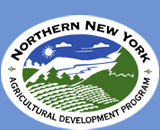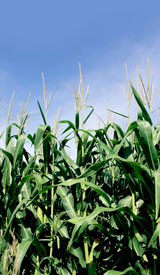

Northern New York Agricultural Development Program Press
Releases
March 24, 2006
Contacts: Michael Hunter, Cornell Cooperative
Extension of Jefferson County, 315-788-8450; Peter Barney, Cornell
Cooperative Extension of St. Lawrence County, 315-379-9192
Background on ASB is online at
www.nnyagdev.org
Battle to Beat Alfalfa Pest Shows Progress,
Testing of Control Methods Continues in 2006
The results of a Fall 2005 field survey shows that all six Northern New
York counties have infestations of alfalfa snout beetle. The pest can
destroy entire fields of alfalfa in one growing season. The economic
loss to dairy farmers is an estimated to be as high as 20 to 30 percent
decrease in net profits on highly infested fields. In 2006, Cornell
University researchers funded by the Northern New York Agricultural
Development Program (NNYADP) will work with NNY Cornell Cooperative
Extension educators to conduct three research projects investigating
ways to beat the beetle.
�One ASB damaged plant is enough to designate a field infested,� says
Cornell Cooperative Extension of Jefferson County Crops Specialist
Michael E. Hunter, �but we are seeing positive results from research
conducted on one of the county�s most heavily affected farms.�
That farm is John Peck�s dairy farm in Great Bend, NY, where the alfalfa
snout beetle (ASB) population exceeded 2.5 million beetles per acre in
the 1990s. From 2002 to 2005, a dramatic decrease of ASB was observed on
the Peck farm.
�We believe that population crash is a result of using a native
entomopathogenic nematode collected in Oswego County on the Peck Farm,�
says Cornell University entomologist Dr. Elson J. Shields.
Entomopathogenic nematodes are microscopic-size worms that destroy
alfalfa snout beetle larvae. Dr. Shields and his research team have
tested two species of nematodes on the Peck farm. In 2006, they will
establish a large-scale trial using the nematodes on four farms: one
each in Jefferson County, Lewis County, St. Lawrence County, and
Franklin County.
While the results have been good at the Peck farm, the 2005 field survey
showed ASB in a field just one mile from the Peck farm. Field trials in
2006 will be expanded to evaluate movement of the beetles and the
nematodes and to test treatments under different soil and environmental
conditions.
�The large-scale field trial data will be valuable in estimating the
portions of fields that need to be treated to establish the native
nematodes as a long-term viable biological control,� Shields says.
Dr. Janice E. Thies has been investigating the use of insect-infecting
fungi as a biological control method for ASB. Three species have
produced 100 percent mortality rates in field trials. Since developing
products for commercial application is costly, in 2006, Thies will
evaluate the efficacy of two already commercially available products
that are the closest match to the fungi showing the positive results.
The products will be tested on beetles collected in Jefferson County.
Also in 2006, Thies will complete field testing of fungi applied at the
Cornell E.V. Baker Research Farm at Willsboro, and will determine
whether spraying or tilling a fungal treatment into the soil of infected
fields is most effective.
The best current method for controlling alfalfa snout beetle is planting
three years of alfalfa in rotation with two years of corn or oats. Thies
and her research team are testing the ability of corn and oat crops to
maintain high levels of the insecticidal fungi in soil. They are also
investigating the effect of the fungi on general soil ecology.
�This research should help save Northern New York farmers thousands of
dollars in crop losses each year in an environmentally friendly manner,�
Thies says.
Cornell University plant breeder Dr. Donald R. Viands is working to
develop an ASB-resistant alfalfa variety. Early research with alfalfa
collected in Jefferson County showed resistance genes existed in some
plants at a low level. The NNYADP research project involves selective
breeding of the most resistant plants from Jefferson County, plants from
Hungary where the alfalfa snout beetle is a native pest, and of elite
germplasm developed by the Cornell Forage Breeding Project.
Using a greenhouse screening method developed with NNYADP funding by
Cornell�s Shields and Antonio Testa, Viands has been able to control the
level and length of infestation to rigorously test the plants at the
Plant Breeding and Genetics greenhouse facilities in Ithaca, NY. The
seed of the most ASB-resistant varieties of alfalfa will be used for
future selection cycles.
�Three or four cycles of selection will be needed to increase the level
of ASB resistance. If significant progress is seen in the greenhouse,
trials will be planted in Northern New York in 2007 to confirm progress
in naturally-infested fields,� Viands says.
Information on alfalfa snout beetle will be provided at meetings March
28 in Malone, March 29 in Lowville, and April 20 in Westport. Contact
Cornell Cooperative Extension in Franklin County, 518-483-7403, Lewis
County, 315-376-5270, or Essex County, 518- 962-4810 for details.
The Northern New York Agricultural Development Program is a
farmer-driven research and education program specific to New York
state�s six northernmost counties (Jefferson, Lewis, St. Lawrence,
Franklin, Clinton, Essex). For more information, visit
www.nnyagdev.org or contact Board
Chairs Jon Greenwood, Canton, 315-386-3231, or Joe Giroux, Plattsburgh,
518-563-7523, or call Dave Smith at Cornell University at 607-255-7286.
